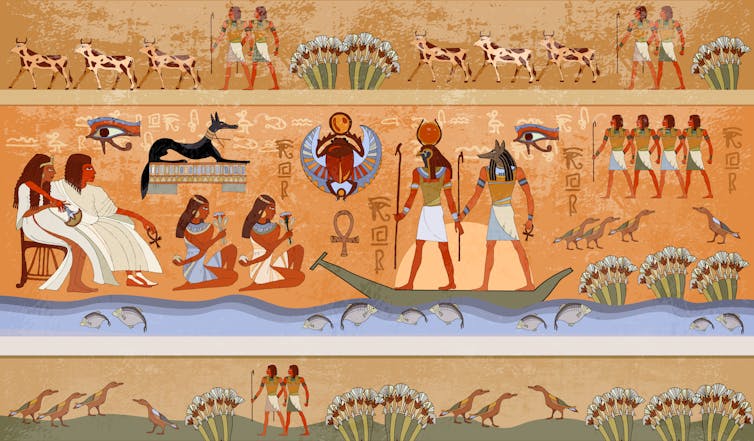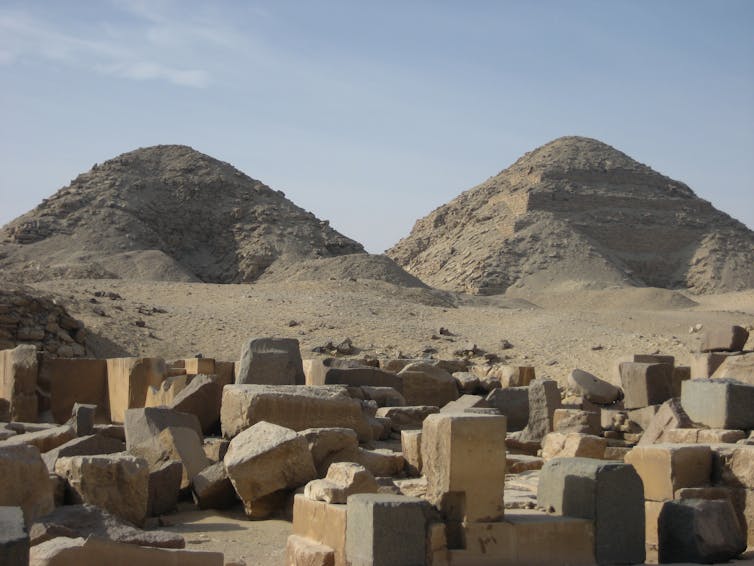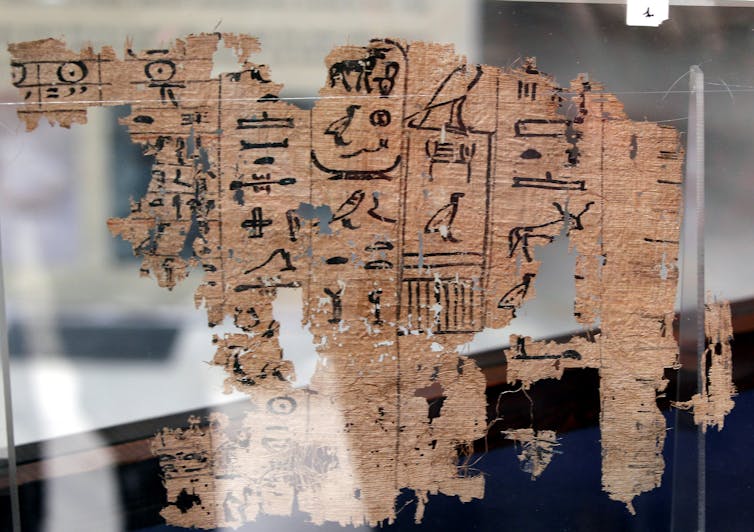Before Queen Hatshepsut's Temple at Deir Al-Bahari on the west bank of the Nile at Luxor, the stage was set for dozens of journalists, photographers, MPs and others to make the journey to the Al-Assasif Necropolis to catch a glimpse of the newly discovered tomb of the overseer of the mummification shrine of the Mut Temple and explore the entrance of a previously undiscovered tomb, dubbed TT28.
At the bottom of a hill and down 10 steps, the tombs are on the edges of a small stony courtyard. On the left-hand side is the newly discovered tomb of the overseer of the Mut Temple, Thaw-Rakhtif, its walls adorned with painted scenes and containing sarcophagi and parts of a funerary collection.
On the right-hand side is the previously undiscovered tomb TT28, together with its original entrance.
Minister of Antiquities Khaled El-Enany told Al-Ahram Weekly that an Egyptian archaeological mission had stumbled upon the discovery after removing 300 metres of rubble during five months of work. He said the discovery highlighted the role and importance of the Al-Assasif Necropolis in the ancient period.
Although the tombs are dated to the Ramesside Period, the sarcophagi and funerary collection inside them do not belong to the owners, but to other officials of the Late Period, indicating that the tombs were reused. Both sarcophagi in the tombs belonged to a man named Padist and his daughter Nesmutamu, a singer to the god Amun-Re.
El-Enany described the sarcophagi as "magnificent" as they show the skills of the ancient Egyptian artisans as well as the high quality of their fabrication. They are carved in black wood and decorated with gilded hieroglyphic symbols, and each has an anthropoid lid depicting the facial features of the deceased and his daughter, with the eyes and eyebrows outlined with golden sheets. Both sarcophagi contain a mummy wrapped in linen sheets.
Mustafa Waziri, secretary-general of the Supreme Council of Antiquities (SCA) who led the mission, said that although the Thaw-Rakhtif tomb was not in good condition, it had a very distinguished funerary collection. Some parts of the walls still retained the original paintings, especially those located near the entrance and the adjacent wall, he said. They show Thaw-Rakhtif in different positions with members of his family and his wife Sekhmet Nefret, a singer of the god Amun-Re.
Waziri said that in a side room inside the tomb a small burial with six unidentified mummified skeletons had been found, among them the skeleton of a baby. "It may be the grave of a family member or a relative, but we cannot say for sure until the completion of the archaeological study," he added.
He said that a collection of more than 1,000 ushabti figurines carved in terracotta, faience and wood in different sizes and shapes had also been unearthed, along with two black wooden statues of Padist, painted wooden statuettes, and five funerary masks.
Two limestone lids of canopic jars and an alabaster jar adorned with a hieroglyphic text painted in green were also unearthed, as well as wooden statues of the god Anubis, a symbolic painted coffin, and parts of statues.
A papyrus inscribed with chapter 125 of the Ancient Egyptian Book of the Dead was among the funerary objects unearthed.

The head of a yet unknown mummified skeleton
SECOND TOMB: Tomb TT28, which belonged to Hori, an officer of Amun during the Ramesside Period, has been uncovered with its original entrance. Waziri said that the original design of the tomb had been discovered, and it was different to the one described on its discovery.
After the announcement of the discovery of the tombs, El-Enany, Waziri, Luxor Governor Mustafa Alham and other attendees headed towards a neighbouring tomb, TT33, which belonged to Pediamenopet, a 26th-Dynasty priest, to witness the opening of an 18th-Dynasty painted coffin unearthed in the tomb's open court.
The coffin is one of two found earlier this month by a Franco-Egyptian mission from the French Institute of Oriental Archaeology (IFAO) and Strasbourg University in France. "The first is a painted rishi-style sarcophagus from the 17th-Dynasty and was opened on its discovery revealing the mummy of a priest," El-Enany said.
This is the second time a minister of antiquities has opened a previously unopened sarcophagus before the world's assembled media. The first was in the early 2000s when former minister of antiquities Zahi Hawass witnessed the opening of a sarcophagus uncovered by a Spanish-Egyptian mission in the adjacent necropolis of Draa Abul-Naga.
Upon removing the lid, the well-preserved mummy of a woman called Thuya was revealed wrapped in linen.
French archaeologist Frédéric Colin who led the excavation told the Weekly that early examination had shown that the mummy belonged to the 18th Dynasty and had been restored and re-wrapped in linen during a later period as the style and way of wrapping were similar to those used in the Late Period.
More research will be needed to understand the discoveries, he said.
Tomb TT33 was originally uncovered in 1737 when British traveller Richard Pocoke visited the area and thought it was part of a subterranean palace due to its vast size. In 1881, the tomb was excavated by Johannes Dümichen from the University of Strasbourg, who reported that it was composed of 22 rooms connected to each other by long corridors on three levels and extending 20 m below ground.
During the recent cleaning, restoration and conservation of the tomb, which contains engravings from the Ancient Egyptian Pyramid Texts and the Book of the Dead, the mission stumbled upon two painted coffins, one of which has been opened.

Archaeologists during the opening of the 18th Dynasty sarcophagus
IPET TEMPLE: At the same time, El-Enany embarked on an inspection tour of the Karnak and Luxor Temples to check the latest development work.
The Karnak Temple is undergoing major improvements to make it the first in Egypt to be friendly to disabled visitors. Wooden ramps and paths for wheelchairs along with information boards accessible to those with impaired sight and hearing have been installed.
Mustafa Al-Saghir, director-general of Karnak Antiquities, explained that the podium area and the area between the Teharaka Column and the open-air museum features ramps 1.5 metres wide for disabled visitors, while a wooden slope has been installed in the Avenue of Sphinxes.
Conservation work at the Ipet precinct in the Karnak Temple is also at full swing to meet the deadline for its opening to the public on World Heritage Day in 2019.
The conservation work includes the cleaning of the temple's walls and ceilings, as well as the consolidation of the paintings.
Bird deposits have been removed and a wooden ramp put in place to facilitate visitors.
The temple is located on the southern axis of the Amun-Re Temple at the Karnak Temple, and according to an ancient Egyptian religious belief was the resting place of Ipet, the goddess of food and protection, when she gave birth to her son Osiris.
The walls of the precinct are decorated with coloured engravings depicting Ipet with different deities, as well as other religious inscriptions.
At the Luxor Temple El-Enany inspected the open courtyard of Ramses II and his newly restored colossi. The court is lined by a double row of 14 columns with lotus-bud capitals and 11 colossi of the king. The columns are decorated with scenes of the Pharaoh making offerings to the gods. On the southern wall is a procession of the 17 sons of Ramses II with their names and titles.
Some of the statues are headless or have collapsed, having probably been damaged during the reign of king Cambyses or afterwards.
"It is time to reassemble these colossi," Waziri told the Weekly, adding that the mission had so far reassembled, restored, and reinstalled the heads of two colossi to their original position, while a third is still under restoration. Each head weighs 250kg.
Still at the Luxor Temple, El-Enany announced that the fifth colossus of Ramses II decorating the temple's first pylon will be restored, reassembled and re-erected to its original position to join its four twins before the pylon.
Over the last two years, the ministry has succeeded in reassembling and lifting up two of the colossi that once decorated the façade of the temple's first pylon. In 1958, an Egyptian archaeological mission led by Mohamed Abdel-Kader uncovered the statues along with others broken into parts as a result of damage sustained during an earthquake in the fourth century CE.
"The blocks were removed and placed [for an interim period] in wooden shelters on the first pylon's eastern side," Waziri said.
The last colossus will be restored in collaboration with an American mission from Chicago.












